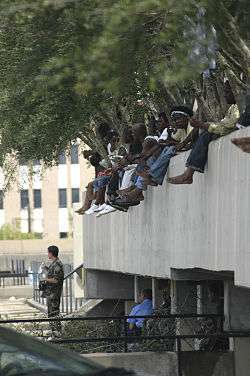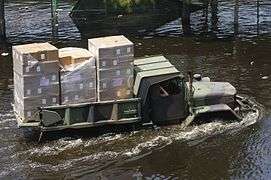Effect of Hurricane Katrina on the Louisiana Superdome

The Louisiana Superdome (which is now known as the Mercedes-Benz Superdome) was used as a "shelter of last resort" for those in New Orleans unable to evacuate from Hurricane Katrina when it struck in late August 2005.
Past hurricanes and Katrina preparation
Hurricane Katrina was the third time the dome had been used as a shelter. It was previously used in 1998 during Hurricane Georges and in 2004 during Hurricane Ivan. During Georges, the Superdome had no problems related to the weather but evacuees stole furniture and damaged property, resulting in thousands of dollars in losses. There were also difficulties supplying the more than 14,000 people living temporarily in the dome with necessities. About a thousand special-needs patients were housed there when Ivan hit the area.
Despite these previous periods of emergency use, as Katrina approached the city, officials had not stockpiled enough generator fuel, food, and other supplies to handle the needs of the people seeking refuge there. According to an article in Time, "Over the years city officials have stressed that they didn't want to make it too comfortable at the Superdome since it was safer to leave the city altogether. "It's not a hotel," the director of emergency preparedness for St. Tammany Parish told the Times-Picayune in 1999."[1]
Hurricane Katrina

Approximately 9,000 residents and 550 National Guardsmen sheltered in the Superdome as Katrina came ashore on August 28, 2005. Maj. Gen. Bennett C. Landreneau, Adjutant General for the Louisiana National Guard, said that the number of people taking shelter in the Superdome rose to around 15,000–20,000 as search and rescue teams brought more people from areas hit hard by the flooding. Officials set up security checkpoints and confiscated alcohol, weapons, and illicit drugs from those seeking refuge in the building.[2]
The Superdome was built to withstand most catastrophes. The roof was estimated to be able to withstand winds with speeds of up to 200 mph (320 km/h) but flood waters could still possibly reach the second level 20 feet (6.1 m) from the ground, making the structure an unreliable shelter in severe rain and wind. When looking into the origins of the claims about 200 mph (320 km/h) wind security in the Superdome, CNN reported that no engineering study had ever been completed on the amount of wind the structure could withstand. The building's engineering study was underway as Hurricane Katrina approached and was put on hold. It was used as an emergency shelter although it was neither designed nor tested for the task. However, the damage to the roof was not catastrophic, with just two relatively small holes and the ripping off most of the easily replaceable white rubber membrane on the outer layer.
On August 29, 2005, at about 9:00 AM EDT, reports from inside the Superdome were that part of the roof was "peeling off," daylight could be seen from inside the dome, and rain was pouring in. The Associated Press stated there were two holes, "each about 15 to 20 feet (6.1 m) long and 4 to 5 feet (1.5 m) wide," and that water was making its way in at elevator shafts and other small openings.[3] The same morning, during an interview on ABC news, Governor Kathleen Blanco called the Superdome shelter strategy an "experiment," when asked if it could hold the storm or the flood.
Lack of supplies and organization
Despite the planned use of the Superdome as an evacuation center, government officials at the local, state and federal level were criticized for poor planning and preparation. On August 28, the Louisiana National Guard delivered three truckloads of water and seven truckloads of MREs (meals ready to eat), enough to supply 15,000 people for three days. However, there was no water purification equipment on site, nor any chemical toilets, antibiotics, or anti-diarrheals stored for a crisis. There were no designated medical staff at work in the evacuation center, no established sick bay within the Superdome, and very few cots available that hadn't been brought in by evacuees. The mayor of New Orleans had stated that as a "refuge of last resort," only limited food, water, and supplies would be provided. Residents who evacuated to the Superdome were warned to bring their own supplies. According to many, the smell inside the stadium was revolting due to the breakdown of hygiene, urinals, and plumbing.
When the flooding began on August 30, the Superdome began to fill slowly with water, though it remained confined to the field level. Later that day, Governor Blanco ordered New Orleans completely evacuated.[2] On August 31, it was announced that the Superdome evacuees would move to the Reliant Astrodome in Houston, Texas. With no power and no water, sanitary conditions within the Superdome had rapidly deteriorated.[4]
Deaths and crime

As of August 31, there had been three deaths in the Superdome: two elderly medical patients and a man who is believed to have committed suicide by jumping from the upper level seats. There were also unconfirmed reports of rape, vandalism, violent assaults, crack dealing/drug abuse, and gang activity inside the Superdome. On September 11, New Orleans Police Superintendent Eddie Compass reported there were "no confirmed reports of any type of sexual assault."
While a few medical patients were able to be transported out by helicopter, it was not until August 31 that the first group of about 100 tourists (mainly international visitors) were "smuggled" out from the Superdome to the Sports Arena next door. This was done as covertly as possible so as to not cause rioting or charges of favoritism.[5]
National Guardsmen, accompanied by buses (475 total) and supply trucks, arrived at the Superdome on September 1. The buses were sent to pick up the evacuees from the Superdome and the Ernest N. Morial Convention Center, where more than 20,000 people had been crowded in similarly poor living conditions. 13,000 evacuees were taken to the Reliant Astrodome in Houston. By September 4, the last large group from the Superdome had been evacuated.
On September 20, speculation arose that the Louisiana Superdome would have to be demolished.[6] Instead, the State of Louisiana chose to repair and renovate the Superdome beginning in early 2006.
Closed for events
Professional sports
After the events surrounding Katrina, the Superdome was not used during the 2005 NFL season. The New Orleans Saints played four of their scheduled home games at LSU's Tiger Stadium in Baton Rouge, three at the Alamodome in San Antonio, and one at Giants Stadium in East Rutherford, New Jersey.[7]
On October 21, 2005, Benson issued a statement saying that he had not made any decision about the future of the Saints.[8] The San Antonio Express-News reported that sources close to the Saints' organization said that Benson planned to void his lease agreement with New Orleans by declaring the Superdome unusable.[9] Ultimately, the Saints announced that they would be returning to New Orleans, with the first home game on September 25, 2006 against the Atlanta Falcons on Monday Night Football. Before that first game, the team announced it had sold out its entire home schedule to season ticket holders — a first in franchise history.[10]
College sports
Tulane Green Wave
Tulane University postponed its scheduled football game against the University of Southern Mississippi until November 26. Their first game, against Mississippi State University, was played on September 17 at Independence Stadium in Shreveport, Louisiana. Overall, the team used six different stadiums for their six home games, including Tiger Stadium in Baton Rouge, Cajun Field in Lafayette, La., Joe Aillet Stadium in Ruston, La., Malone Stadium in Monroe, La., and Ladd Peebles Stadium in Mobile, Ala.
Bayou Classic
The Bayou Classic was moved from the Superdome to Reliant Stadium in Houston, Texas. Grambling State University beat Southern University, 50-35.
New Orleans Bowl
The 2005 New Orleans Bowl between the University of Southern Mississippi and Arkansas State University was moved from the Superdome to Cajun Field in Lafayette. Southern Miss won over ASU, 31-19.
Sugar Bowl
The 2006 Sugar Bowl, which pitted the University of Georgia Bulldogs against the West Virginia University Mountaineers, was moved from the Superdome to the Georgia Dome in Atlanta. The Mountaineers won, 38-35.
Gallery
 Roof damage from Katrina.
Roof damage from Katrina. A FEMA medical team at the Superdome, Aug 31.
A FEMA medical team at the Superdome, Aug 31. First delivery to Superdome, Aug 31.
First delivery to Superdome, Aug 31. Overhead view of the Superdome. August 30, 2005.
Overhead view of the Superdome. August 30, 2005. An aerial view of the flooding near downtown New Orleans.
An aerial view of the flooding near downtown New Orleans. Local residents stand outside of the Superdome, September 2.
Local residents stand outside of the Superdome, September 2.
See also
- New Orleans Morial Convention Center, Katrina evacuation point
References
- ↑ 4 Places Where the System Broke Down Amanda Ripley. Time. September 13, 2005.
- 1 2 Governor: Evac Superdome, Rescue Centers Fox News. August 30, 2005.
- ↑ Photo in the News: Hurricane Shreds Superdome Roof, National Geographic. August 29, 2005.
- ↑ Britons describe hurricane ordeal. BBC. September 6, 2005.
- ↑ Paul Harris, Diary From The Dome, Reflections on Fear and Privilege During Katrina Vantage Press 2008
- ↑ Superdome may have to be demolished Fanblogs College Football blog. September 6, 2005
- ↑ Saints' home games: 4 at LSU, 3 in Alamodome. ESPN. September 12, 2005.
- ↑ http://www.nola.com/sports/t-p/index.ssf?/base/sports-20/1129961793235820.xml Times-Picayune.
- ↑ Benson to bail on Superdome Express-News. October 21, 2005.
- ↑ http://www.nfl.com/teams/story/NO/9671853 NFL.com.